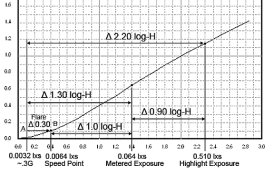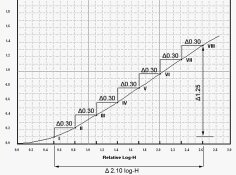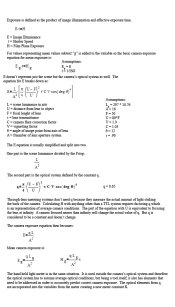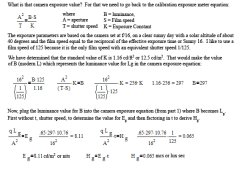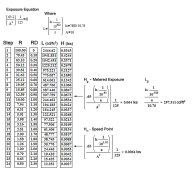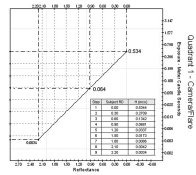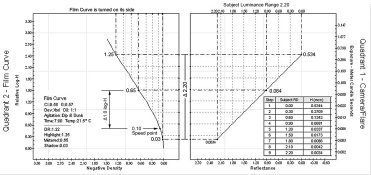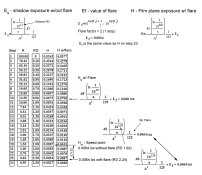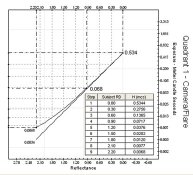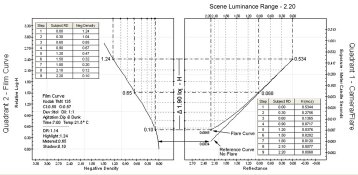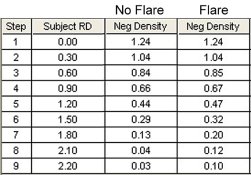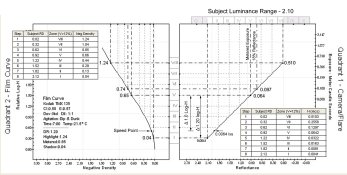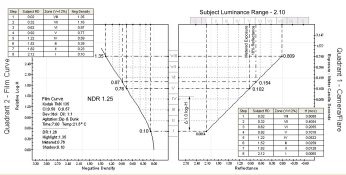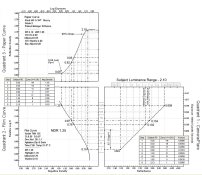Stephen Benskin
Member
Now that we know our target exposures for the speed point and metered exposure point, let's see how we can use them to evaluate a film testing procedure. I'd like to use the Schaffer method of contacting a step tablet with the film and using a camera to regulate the exposure. For the test exposure, the instructions are to meter a surface and open up 5 stops. For a 125 speed film, we know the metered exposure at the film plane is 0.064 lxs. Five stops over that is 2.048 lxs.
At what step tablet density would the incident exposure of 2.048 lxs (light falling on the step tablet) create a film plane exposure of 0.064 lxs (light transmitted through the step tablet)? Since the instructions were to open up 5 stops over the metered exposure and since step tablets consist of 10 stops of density, I'm going to use a the middle step which is half the total 3.0 density of the step tablet or a density of 1.50.
The equation to determine the amount of light transmitted through a unit of density is to multiply the illuminance by the reciprocal of the antilog of the step tablet density - 1/10^density * illuminance.
1/10^1.50 * 2.048 = 0.065 lxs
This validates using an exposure of 5 stops over the metered exposure for the test exposure. We know the speed point exposure is 1.0 logs below the metered exposure point or at a step density of 1.0 units higher or a step tablet density of 2.50.
1/10^2.5 * 2.048 = 0.0065 lxs
For a 125 speed film, the film density of 0.10 over Fb+f should result from the exposure at the step tablet density of 2.50. Schaffer, however, uses the step tablet density of 2.70 for the target speed point density. That is 0.20 logs or 2/3 stop difference in exposure. This indicates Schaffer’s test is using a different speed point than the ISO standard and consequently will produce different film speeds under the same conditions. What would the film speed be at 2.70?
1/10^2.70 * 2.70 = 0.0041 lxs
In order to achieve a film density of 0.10 at the step tablet density of 2.70, the film speed would have to be 195. But that is not how Schaffer describes this part of determining the EI. What he proposes is to determine the exposure difference between the density at 2.70 and where 0.10 falls and adjust the EI value accordingly. As we know that point is at a step tablet density of 2.50 or a 2/3 stop difference. For the 0.10 density to fall at the step tablet density of 2.70, the exposure of the step tablet would have to be increased by 2/3 stop which would indicate the film EI to be 2/3 stop slower than the 125 speed film that it is. This method would produce EIs in line with the typical EIs from Zone System testing methods which consistently result in speeds ½ to 1 stop slower than the ISO film speed.
Whether or not Schaffer’s testing method produces more favorable film speeds is up to the individual. What we now know is that the method uses testing parameters that are different than the ISO method and close to the parameters and results obtain with Zone System testing. In my opinion, I would find this analysis valuable when choosing a testing methodology.
At what step tablet density would the incident exposure of 2.048 lxs (light falling on the step tablet) create a film plane exposure of 0.064 lxs (light transmitted through the step tablet)? Since the instructions were to open up 5 stops over the metered exposure and since step tablets consist of 10 stops of density, I'm going to use a the middle step which is half the total 3.0 density of the step tablet or a density of 1.50.
The equation to determine the amount of light transmitted through a unit of density is to multiply the illuminance by the reciprocal of the antilog of the step tablet density - 1/10^density * illuminance.
1/10^1.50 * 2.048 = 0.065 lxs
This validates using an exposure of 5 stops over the metered exposure for the test exposure. We know the speed point exposure is 1.0 logs below the metered exposure point or at a step density of 1.0 units higher or a step tablet density of 2.50.
1/10^2.5 * 2.048 = 0.0065 lxs
For a 125 speed film, the film density of 0.10 over Fb+f should result from the exposure at the step tablet density of 2.50. Schaffer, however, uses the step tablet density of 2.70 for the target speed point density. That is 0.20 logs or 2/3 stop difference in exposure. This indicates Schaffer’s test is using a different speed point than the ISO standard and consequently will produce different film speeds under the same conditions. What would the film speed be at 2.70?
1/10^2.70 * 2.70 = 0.0041 lxs
In order to achieve a film density of 0.10 at the step tablet density of 2.70, the film speed would have to be 195. But that is not how Schaffer describes this part of determining the EI. What he proposes is to determine the exposure difference between the density at 2.70 and where 0.10 falls and adjust the EI value accordingly. As we know that point is at a step tablet density of 2.50 or a 2/3 stop difference. For the 0.10 density to fall at the step tablet density of 2.70, the exposure of the step tablet would have to be increased by 2/3 stop which would indicate the film EI to be 2/3 stop slower than the 125 speed film that it is. This method would produce EIs in line with the typical EIs from Zone System testing methods which consistently result in speeds ½ to 1 stop slower than the ISO film speed.
Whether or not Schaffer’s testing method produces more favorable film speeds is up to the individual. What we now know is that the method uses testing parameters that are different than the ISO method and close to the parameters and results obtain with Zone System testing. In my opinion, I would find this analysis valuable when choosing a testing methodology.
Last edited by a moderator:


